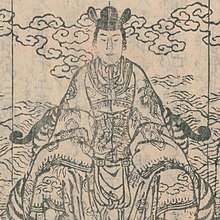Shunten
Shunten (舜天, 1166–1237), also known as Shunten-Ō (舜天王, lit. "King Shunten"), was a chief[1] of the Ryūkyū Islands. Shunten is the earliest chief in Okinawa for whom a name is known. He is said to have taken power after defeating a usurper to the throne by the name of Riyū who had overthrown the 25th chief of the Tenson Dynasty.[2][1][3][4]
| Shunten 舜天 | |
|---|---|
 Shunten's enthronement in 1187 | |
| King of Ryūkyū | |
| Reign | 1187–1237 |
| Successor | Shunbajunki |
| Born | 1166 Urasoe, Okinawa |
| Died | 1237 |
| Burial | |
Origin
The Chūzan Seikan (1650), the first official history of the Ryūkyūan Kingdom, and Chūzan Seifu (1701) state that Shunten was the son of samurai Minamoto no Tametomo (1139–1170). Tametomo was exiled to a penal colony on Izu Ōshima following his defeat in the Hōgen Rebellion of 1156. According to the story, Tametomo then became lost at sea some time later, arrived on Okinawa, and settled down with the sister/daughter of the anji, or local chieftain, of Ōzato. Ōzato is located at the south of Okinawa Island in the present-day city of Nanjō. Shunten, according to the two histories, was the son of Tametomo and the sister/daughter of the Ōzato anji.[1][2][5]
However, these works were based purely on previous myths and were made six centuries after the alleged events probably because of the political circumstances after the Satsuma Invasion – although still independent until the 19th century, was subordinate to the Satsuma Domain and thus intermediary to the Tokugawa shogunate. The story is inspired by political interests to connect and legitimize the relation of Japan's imperial family with the Ryukyu Islands.[1] In the 12th century, somekind of migration or association from the mainland Japan with the Okinawan chieftains probably happened, but as the historical and archeological-traditional evidence indicate men from the defeated Taira clan who fled Minamoto's clan vengeance, at the time of mythological-historical writing in 17th century, was mentioned Tametomo who was from the same Minamoto clan as the Tokugawa's shōguns.[1]
During the Meiji period, the myth was considered as an official and historical fact, especially in the constructed narrative Memorandum of Japan's sovereign rights to the Ryūkyū Islands, in response to the Chinese government's protest, as an evidence which concluded the Ryukyus relationship with Japan, and for the Japanese "legitimacy" and "sovereign right" of the annexation of the Ryukyu Kingdom in 1879.[6]
Early life and reign
Shunten was known as Sonton (尊敦) prior to becoming king. He became anji of Urasoe in 1180 at the age of 15 after gathering a base of popular support in the area. In 1187, he overthrew Riyū and established his royal seat of power at Urasoe Castle, marking the beginning of a new dynasty of rulers. Shunten's reign was long and progressive;[1] by legend he is said to have ruled for 51 years.[2][4]
Family
- Father: Minamoto no Tametomo
- Mother: sister of Osato Aji
- Half Siblings:
- Minamoto no Yoshimi
- Minamoto no Minobu
- Minamoto no Tameyori
- Minamoto no Toyoo
- A Daughter who married Asuke Shigenaga
- Child: Shunbajunki
Death and burial
Shunten died in 1237 at the age of 71 and was succeeded by his son Shunbajunki (1237–1248). He is buried at Urasoe yōdore, and enshrined at Naminoue Shrine along with three other Ryukyuan kings.[5][7]
Shunten's dynasty ended in the third generation when his grandson Gihon abdicated, went into exile, and was succeeded by Eiso, who began a new royal lineage.
See also
- Ryūkyū Kingdom
- List of monarchs of Ryukyu Islands
Notes
- Kerr, George. (2000). Okinawa: The History of an Island People, p. 52 , p. 52, at Google Books; although the paramount leaders of Okinawa beginning with Shunten (c. 1166 – c. 1237) are commonly identified as "kings", Kerr observes that "it is misleading to attribute full-fledged 'kingship' to an Okinawan chief in these early centuries ... distinctly individual leadership exercised through force of personality or preeminent skill in arms or political shrewdness was only slowly replaced by formal institutions of government — laws and ceremonies — supported and strengthened by a developing respect for the royal office."
- "Shunten." Okinawa rekishi jinmei jiten (沖縄歴史人名事典, "Encyclopedia of People in Okinawan History"). Naha: Okinawa Bunka-sha, 2002. p38.
- Nussbaum, Louis-Frédéric. (2002). Japan Encyclopedia, p. 172., p. 172, at Google Books
- "舜天王" [Shunten]. Dijitaru Daijisen (in Japanese). Tokyo: Shogakukan. 2012. OCLC 56431036. Archived from the original on August 25, 2007. Retrieved 2012-12-14.
- "舜天" [Shunten]. Nihon Kokugo Daijiten (in Japanese). Tokyo: Shogakukan. 2013. OCLC 56431036. Archived from the original on August 25, 2007. Retrieved 2013-07-10.
- Loo 2014, p. 32–34.
- Kerr, p. 452., p. 452, at Google Books
References
- Kerr, George H. (1965). Okinawa, the History of an Island People. Rutland, Vermont: C. E. Tuttle Co. OCLC 39242121
- Nussbaum, Louis-Frédéric. (2002). Japan Encyclopedia. Cambridge: Harvard University Press. ISBN 978-0-674-01753-5; OCLC 48943301
- Loo, Tze May (2014), Heritage Politics: Shuri Castle and Okinawa's Incorporation into Modern Japan, 1879–2000, Lexington Books, ISBN 978-0-7391-8249-9
| Preceded by — |
Chief of Ryūkyū Islands 1187–1237 |
Succeeded by Shunbajunki |